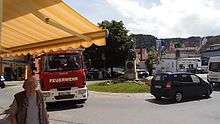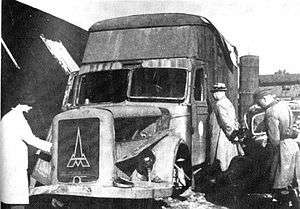Magirus
| GmbH | |
| Industry | Automotive |
| Founded |
1866 (As Magirus Kommanditist) 1974 (Magirus-Deutz) 1983 (Iveco Magirus) |
| Founder | Conrad Dietrich Magirus |
| Headquarters | Ulm, Baden-Württemberg, Germany |
Number of locations |
Production locations: Germany:Ulm Austria:Graz France: Chambéry Italy: Brescia |
Area served | Worldwide |
Key people | |
| Products | Trucks |
|
| |
| Owner | CNH Global |
Number of employees | 2,100 (2009) |
| Parent | Iveco |
| Website | www.magirusgroup.com |

Magirus GmbH[1] is a truck manufacturer based in Ulm, Germany, founded by Conrad Dietrich Magirus (1824–1895). The company began manufacturing fire-fighting vehicles in 1866. In the late 1910s, it started the production of trucks and buses. These vehicles developed a reputation for high engineering standards, able to operate under the most arduous conditions.
The company also invented the turntable ladder, as Magirus Leiter, which quickly became an essential item of fire brigade equipment worldwide.
The parent company was Klöckner Humboldt Deutz AG, maker of the well-known Deutz engines, so the brand commonly used was Magirus Deutz, and for a short time Klöckner. The logo of Magirus Deutz was a stylised M with a sharp, long center point to represent the tower of the Ulm Cathedral.
In 1975, Magirus became part of Iveco which continued producing some Magirus trucks for a short while under the name "Iveco Magirus" before abandoning it completely in most countries. KHD's collaboration with Fiat ended abruptly and less than harmoniously in 1979, leaving Fiat as owner of the Magirus-Deutz brand.[2] However, Iveco trucks were sold under the Magirus brand in Germany and other European and Middle Eastern markets until the end of the 1980s. Today, the Magirus brand is only used for the company's firefighting equipment section, not for the whole fleet of manufactured trucks.
Most trucks from Magirus were also known as Magirus-Deutz because their air-cooled engine came from the factory of Deutz AG. These engines are still being sold for agricultural and marine use.
Iveco Magirus is one of the leading manufacturers of fire fighting equipment. The underpinnings for the line of fire fighting trucks are primarily Iveco's own chassis designs and engines, but occasionally platforms from other truck manufacturers serve as the base for specialized or customized fire-fighting equipment layouts. With its Magirus brand turntable ladder, Iveco Magirus is the unrivalled global market leader by sales.
Airship ladders
Though seldom seen today, the Magirus company produced almost all of the early, movable ladders used in the construction of large, rigid airships in both the Germany and the United States. The multi-extension, wooden ladders were mounted on massively constructed, wooden carriage frames with a "fifth-wheel" style, forward axle assembly. Although it appeared to be designed for horses, the ladders could be easily moved by two men. The carriage was equipped with four, hand screw type "outriggers" that would resist the ladder from tipping. The ladder did not swivel on the carriage. It was elevated and extended only towards the front of the carriage. In the "working" position, the ladder had to be elevated to about an 80 degree angle in order to allow full extension to 85 feet. (I do not know what the maximum extended length of the largest wooden Magirus ladder was, but the ones used during the erection of the Goodyear-Zeppelin Corporation's USS AKRON and USS MACON reached to 85 feet.)
They can be seen, commonly, in early photographs of airships under construction in the 1920s and 1930s.
In the Soviet Union
In 1974 the firm was awarded a contract (called the Delta Project) for delivery in 1975-1976 of about 9,500 dumper and flatbed trucks (Magirus М232 D19 and M290 D26) to the USSR to work on the construction of the Baikal–Amur Mainline (BAM).[3][4] This order was the largest in the company's history. These models were export only options KHD products on the domestic market of Germany were not supplied. By January 1, 1975 for the first batch of Magirus for BAM building was ready to be sent to the Soviet Union. Many of these trucks are working now. Largely because of this single order, in 1975 export products accounted for 70% of total production Magirus-Deutz, and the firm took the second place among the German truck manufacturers.
In 1982 Magirus-Deutz erstwhile owners KHD sold the licensing rights for Soviet production of up to 25,000 Series 413 diesel engines. These were meant to be installed in heavy USSR trucks and other vehicles.[2]
Products
Current products
- Iveco Magirus Eurocargo
- Iveco Magirus Stralis
- Iveco Magirus Trakker
Gallery
 Magirus Fire Engine Model "Bayern" 1923
Magirus Fire Engine Model "Bayern" 1923 Horse drawn fire engine, 1926
Horse drawn fire engine, 1926 Magirus Fire Engine 1961
Magirus Fire Engine 1961 Magirus in the USSR
Magirus in the USSR- Iveco Magirus fire engine
 Volvo Magirus fire engine
Volvo Magirus fire engine Japanese Fire Service Hino Motors Magirus fire engine
Japanese Fire Service Hino Motors Magirus fire engine Italian Fire Service vehicles with an Astra crane on the left and a Magirus turntable ladder on the right, Army Parade in Rome, 2 June 2006.
Italian Fire Service vehicles with an Astra crane on the left and a Magirus turntable ladder on the right, Army Parade in Rome, 2 June 2006. Magirus-Deutz truck, similar to those used as gas vans in Chełmno extermination camp
Magirus-Deutz truck, similar to those used as gas vans in Chełmno extermination camp Magirus ladder on floor at front of USS MACON
Magirus ladder on floor at front of USS MACON Several Magirus ladders in use on the construction of a rigid airship. (Notice men at the very top of several ladders.)
Several Magirus ladders in use on the construction of a rigid airship. (Notice men at the very top of several ladders.)
Timeline
- 1864 - Founded by Conrad Dietrich Magirus
- 1872 - 1872 2-wheel hand ladder climbable when free-standing, model »Ulmer Ladder«
- 1892 - First horse-pulled rotating ladder 25 m
- 1904 - First steam powered self-propelled “fire engine”
- 1916 - First fully automatic drive turn table ladder in the world
- 1917 - Production of Magirus motor vehicles
- 1931 - First turn table ladder with steel ladder set
- 1936 - Fusion with Humboldt-Deutz Motorenfabrik
- 1951 - Made the highest turntable ladder in the world 52 m
- 1953 - First turntable ladder with hydraulic drive
- 1965 - First forward control truck chassis
- 1971 - First rescue vehicle RW-rail for subway and local railway operation
- 1972 - First large airport crash tender
- 1980 - First turntable ladder »low-design«
- 1986 - First computer controlled turntable ladder
- 1987 - Take over of previous Bachert production plant in Weisweil, Germany
- 1992 - Iveco Mezzi Speciali, Brescia, Italy
- 1994 - First articulated ladder DLK 23-12 GL CC
- 1996 - Production start of light pumper vehicles in Görlitz/Germany
- 1997 - Lohr-Magirus in Graz/Austria
- 2000 - First oscillation-free turntable ladder (Computer Stabilized)
- 2005 - „Firework of Novelties“ at the Interschutz in Hannover
- 2007 - New modular bodywork generation AluFire 3
- 2010 - Presentation of the models M 32 L-AT, M 33 P, SuperDragon 2, MultiStar2 at the Interschutz in Leipzig
See also
References
- ↑ "Die wichtigsten Unternehmen des Jahres 2009 - Welt Online". Top500.welt.de. 2011-07-05. Retrieved 2012-01-26.
- 1 2 Kacher, Georg (September 1982). Kennett, Pat, ed. "Intertruck: Germany". TRUCK. London, UK: FF Publishing Ltd: 21.
- ↑ http://www.magirus-deutz.ch/geschichte_t5.html see 1974- das "Delta-Projekt" (deutsch)
- ↑ http://mirtransporta.ru/fun/747-magirus-neprostaya-istoriya.html http://mirtransporta.ru/fun/747-magirus-neprostaya-istoriya.html (russian)
External links
| Wikimedia Commons has media related to Magirus vehicles. |